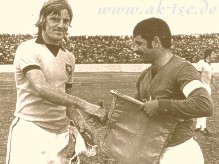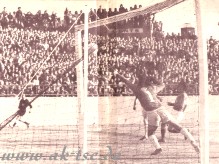

Rasic's 22 man squad for
the Iran games didn't contain any major surprises, with the only real omissions being
Bobby Hogg, who had broken his leg in a club match, and Keeper Jack Reilly.
Reilly had made himself unavailable because of his unwillingness to commit to the
national team's training schedule.
Iron man defender Manfred Schaefer was out after having had an operation, and Johnny
Watkiss was being prepared for the stopper's position. First Keeper Ron Corry's name was
also missing from the list and the long-standing Aussie number one's career in the
national team was now over. The squad for the Iran games was.
GOALKEEPERS: James Fraser, Jimmy Milisavljvic.
DEFENDERS: Doug Utjesenovic, Harry Williams, Peter Wilson, John Watkiss,
George Harris, Col Curran.
MIDFIELDERS: Ray Baartz, Jim Mackay, Ray Richards, Jim Rooney, John
Warren, John McDonald.
FORWARDS: Atti Abonyi, Joe Alagich, Adrian Alston, Max Tolson, Branko
Buljevic, Billy Vojtek, Peter Ollerton, Ernie Campbell.
 Iran
made the mistake of visiting New Zealand on its way to Sydney. It was there, in a 1-1 draw
with Canterbury Province in Christchurch that Iran's star Ali Parvin suffered the injury
that keep him out of the World Cup match. Parvin limped of the ground with
blood streaming from a deep cut that required seven stitches just below the knee.
Iran
made the mistake of visiting New Zealand on its way to Sydney. It was there, in a 1-1 draw
with Canterbury Province in Christchurch that Iran's star Ali Parvin suffered the injury
that keep him out of the World Cup match. Parvin limped of the ground with
blood streaming from a deep cut that required seven stitches just below the knee.
Australia played a practice match against the New South Wales
under 23 team in Sydney. Rasic had his players playing in different positions because the
Iranian Coach was watching the game.
After the match the Iranian coach said that Iran would have no problems in booting
the Socceroos out of the Tournament. Another of Rasic's ruses was to put
photographs of every Iranian player on the wall of the training shed. He told to Socceroos
to memorise the face of the player he would be marking or playing against. The first of
the two matches was to be played in Sydney 1973
AUSTRALIA - IRAN
 A crowd
of 30,881 people turned up at the Sydney Sports Ground on August 18 to watch the vital
match, refereed by Rudolf Scheurer of Switzerland.
A crowd
of 30,881 people turned up at the Sydney Sports Ground on August 18 to watch the vital
match, refereed by Rudolf Scheurer of Switzerland.
Many of the spectators were ethnic people who went to barrack for the Socceroos,
but the majority were Australian Anglo Saxons who more than ever before in the modern era,
were becoming conscious of the Australian National team.
While Australia was battling it out with its Asian neighbours, Iran was doing the
same thing against its Arab brethren Kuwait and Syria, and North Korea in Sub-Group B2.
The winners of the two groups had to meet home and away for a place in the 1974 World Cup.
Iran, with the population of 31 million, was fiercely fanatical about its football. If
some of the experts in Sydney were expecting an easy path to the next stage, then the
Iranians didn't quite see it that way.
Iran kicked off aided by a strong wind at their backs.
Australia went straight into the attack as usual with no nonsense play, and Abonyi and
Baartz combined in a good move that had the word danger written all over it. But
unfortunately Alston was ruled off side and the Swiss Knight of the whistle, Referee
Rudolf Scheurer gave Iran a free kick.
Australia remained
on the attack ignoring the wind and got a free kick when Ghelchikhani brought Baartz down
heavily. From the free kick the ball went to Alston who tried to break clear but was
stopped by Kargarjam. Iran counter attacked, and Mazloumi threw away an excellent chance
when he shot wide.
Then Richards took a corner kick for Australia, and Baartz hit a strong drive, but it was
saved on the line by Kashani, an Iranian defender.
For Iran the danger man was Mazloumi. Each time he got inside
the Australian penalty-area there was much concern. Early in the match the Iranian
goalkeeper Hejazi, failed to hold a high ball that was picked up by Johnny Warren, who
caused much panic to the Iran defenders.
Iran then had Australia defending three consecutive
corners, when the Green and Gold defence looked a little bit nervous. Then Warren took the
ball up from the back and came one on one with the Iran goalkeeper, but at the last moment
ran out of steam and finished badly.
But soon Iran began to give way to the fitter Australian team. Iran goalkeeper became too
nervous, but Hejazi stopped a sizzler from Abonyi in the 32nd minute.
The action started from a throw in by Richards, then Alston headed the ball down Abonyi,
who hit it hard.
But the Iranian goalkeeper could do nothing to stop
Alston's shot in the 42nd minute. With a huge amount of pressure Australia took the lead
just three minutes before half time when there was a lot of confusion in the penalty area
after Warren had headed on a Doug Utjesenovic free kick. The keeper saved once, and again
a shoot from Baartz, but then Alston crashed home one of his famous kicks. From that
moment on Australia was in complete command of the game.
Iran’s Sadeghi came
on at half time for Irinpak who had broken his leg after replacing another casualty,
Rahminipour.
Within seconds of the second half re-start, Abonyi
put his country two up after a Baartz pass. Abonyi ran from mid-pitch, chased by his
opponent. But the St.George forward was too speedy.
From a near impossible position, his hard shot crashed into the top right corner of
the goal, and gave the keeper no chance. It was one of the best goals ever seen in
Australia.
Iran were down for the count.
Atti Abonyi electrified
the large crowd. In one of his finest periods of international football, Abonyi celebrated
his 27th birthday two days ago, by tying the Iranian defence in knots and shooting at
every opportunity.
Iran never seemed to trouble the Australians, who played a typical English style of
football and were very disciplined in all areas. Australia lacked an individual star
player, however, as a team, they were in harmony and managed to play a game without
needing to rely on any one individual's skill or talent. Iran, on the other hand, had many
star players. Head to head, they had superior talent to the Australians.
 Iran's
dominance of Asian Football was very evident in their game. The Iranians' passion for
football and the national team has reached its summit after the its second consecutive
Asian Championship won in Thailand a year before. The players were national heroes in
their country.
Iran's
dominance of Asian Football was very evident in their game. The Iranians' passion for
football and the national team has reached its summit after the its second consecutive
Asian Championship won in Thailand a year before. The players were national heroes in
their country.
Australia’s midfield trio of John Warren, Ray Richards
and Jim Mackay was disappointing. Richards said afterwards: “It was not one of my
best games, I could have done much better.
”Warren, who had been ill the previous night was
virtually unsighted during the second half and Mackay, the best of the trio, was not as
imaginative or as mobile as usual.
Luckily the full backs, Doug Utjesenovic and Col Curran, made up for the midfield
weaknesses with their brilliant overlapping play. Abonyi was the outstanding player of the
match.
The Socceroos had a few more chances to put the
result beyond doubt, but the fanatical crowd had to wait until seven minutes from time.
Utjesenovic took a free kick from the right side. It was one of his typical kicks,
and the ball went high into the goalmouth and found skipper Peter Wilson at the right
place to use his height to head in the final goal. Wilson made the Iranian keeper look
helpless.
3:0 - what a score in a first match for a home and away series!
After a few minutes of
holding the ball in its own ranks, the final whistle sounded. The game was over. Winning
the first leg by three goals was a great success but it really should have been a greater
margin.
The Iranians thoughts must have run to Teheran where
a fanatical crowd would help them, perhaps to get a better result. No one in the
Australian team had any idea what was awaiting them in Teheran. Short after the first-leg
match, the Socceroos left Sydney and flew to Teheran. The return leg was just a week after
the first, so both teams ended up flying out of Australia on the same plane. The players
had time to exchange small talk with their opponents. The Iranians were probably thinking
it was over for them but did not want to give up without a fight either.
 When
the plane landed at Teheran airport, a few thousand angry soccer fans are waiting outside.
But they did not came to make trouble for the Socceroos, they had all turned out to
demonstrate against the Iranian team because of its bad performance in Sydney. The crowd
was pelting the players with everything they could lay their hands on, and the police had
to escort both teams out of the airport's back exit.
When
the plane landed at Teheran airport, a few thousand angry soccer fans are waiting outside.
But they did not came to make trouble for the Socceroos, they had all turned out to
demonstrate against the Iranian team because of its bad performance in Sydney. The crowd
was pelting the players with everything they could lay their hands on, and the police had
to escort both teams out of the airport's back exit.
Australia had brought its own food and water, because Rasic knew from past experience that this will be a problem. It was not easy to hold normal training sessions, and on a few days the coach made the decision to train in a big, empty hall near the hotel.
Everywhere in Teheran,
when the Socceroos went out of the hotel, people would hold up four fingers to let the
Australians know that they believed Australia would get beaten by this margin.
No one in the team thought this possible, so everyone was looking forward to the match.
But no one had the idea that the match will be a ride
through hell.